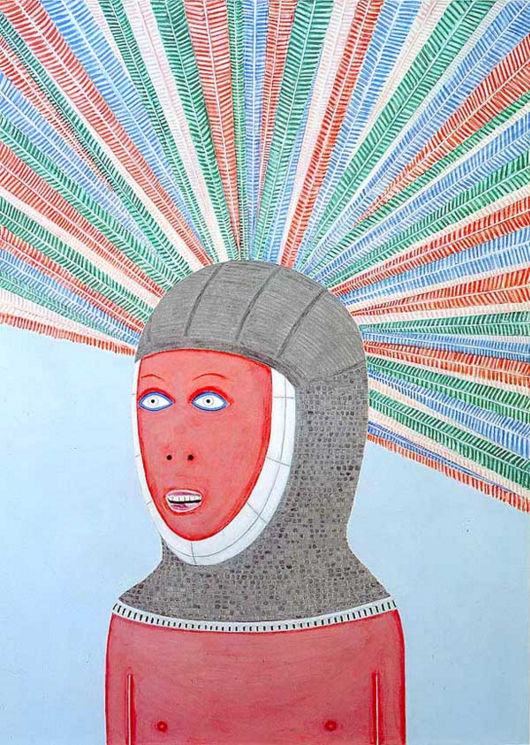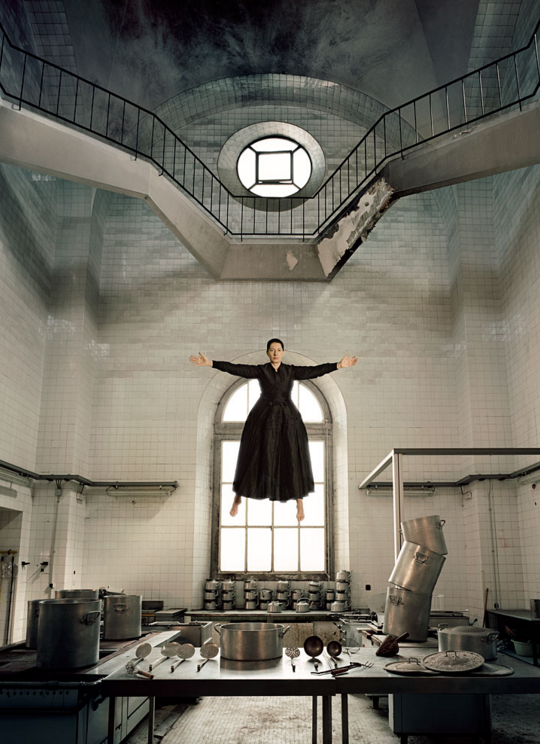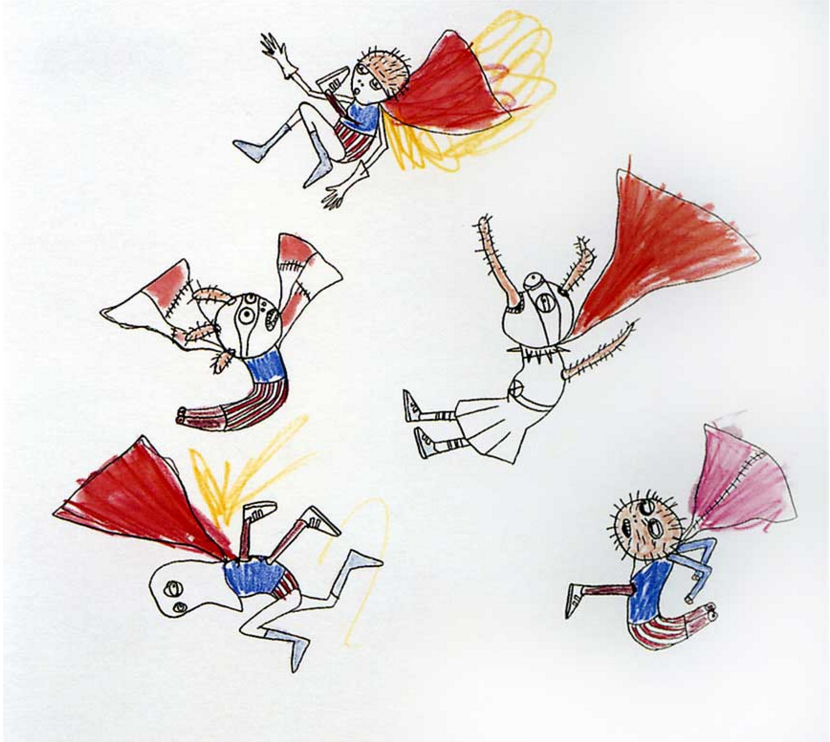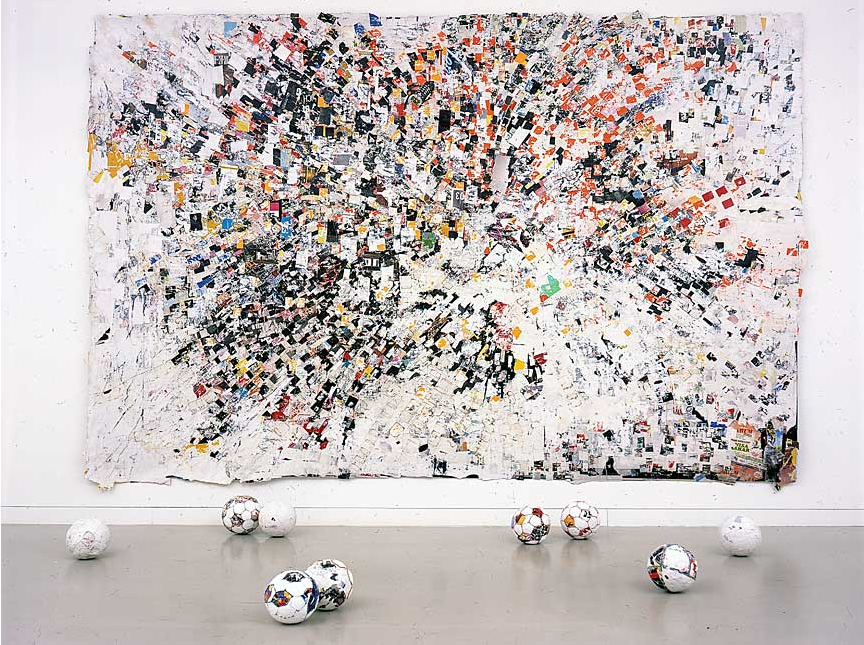
Laylah Ali. Untitled, 2004
Gouache on paper, 28 3/16 x 20 1/6 inches. Courtesy 303 Gallery, New York.
“What is art but a way of seeing?” —Thomas Berger
Sometimes the most significant revolutions make no noise at all, happening completely within someone’s frame of mind. These individual transformations might not make the same splash as a mass protest, but they’re a powerful part of what makes revolutionary movements possible. As Henry David Thoreau wrote, “Things do not change; we change.”
Educators are perhaps the most direct link to catalyzing these internal developments in future generations, and art educators in particular are actively engaged in expanding students’ perspectives and propensity for critical thinking. To illustrate this, we asked three alumni of the ART21 Educators program to share the personal revolutions they’ve witnessed through exposure to innovative artistic practices in the classroom.
Make Your Own Rules
Renee Bareno, high school visual art teacher
Aaron School, New York, NY

Marina Abramović. The Kitchen I, 2009. From the series The Kitchen, Homage to Saint Therese. Color Lambda print; 210 x 160 cm. Courtesy the Marina Abramović Archives and Sean Kelly Gallery, New York. © Marina Abramović
This year I designed a unit titled “Identity and Ingenuity.” I wanted students to create work while simultaneously exploring who they were across the various communities that they traverse. I also wanted to encourage the idea that if they could imagine it, they could create it. I teach at a small private high school for students with special needs, learning differences and learning disabilities. My students provide a wide variety of cognitive, ethnic and economic diversities but with careful differentiation, I was pretty certain that everyone was going to get an opportunity to find their way in the arts.
One student in particular, whom I have worked with for six years, really had a breakthrough early in the semester. In the very beginning, years ago, he was barely able to get more than a few lines down on paper before becoming distracted and leaving his work. Last year something really clicked and he started completing drawings. Other teachers noticed that he was always carrying around a sketchbook and drawing in it. At first they thought it might be a distraction but they all conferred that in fact it was helping him focus and that he was not only learning all of his materials across disciplines, but that he was also building on his critical thinking skills.
This year, while exploring the theme of “Identity and Ingenuity,” he started creating complex mixed media pieces, but the really beautiful thing was that he was able to articulate his process and explain that by imposing a self-prescribed rule to follow, he was able to finish. He was also verbally expressing his appreciation and fascination about working in layers and exploring working with varied mediums. This was coming from a kid who needed structure and clear boundaries across all academic disciplines but in art, he was creating them for himself and really understanding what he was doing. His work has become so rich, just as his verbal descriptions of his process of working on abstract mixed media have become. So far, a great year!
Find Your Own Heroes
Jack Watson, visual art and art history teacher
Chapel Hill High School, Chapel Hill, North Carolina

Laylah Ali. Untitled, 2002. Gouache, watercolor pencil & ink on paper, 10 1/4 x 11 1/2 inches. Courtesy 303 Gallery, New York.
One of my advanced students recently had a total shift in her thinking about art. She had been doing large-scale realistic portraits with some success, but she confessed that it was satisfying but ultimately boring and superficial. I took students to see an artist talk by Farrah Karapetian, who makes large format photograms as a meditation on relationships and identity. To make these works, Farrah spends time with her subject, getting to know them and involving them in her process. Farrah visited our class for an intimate conversation about art, and this student decided to scrap her previous series of portraits and instead focus on experiential art.
To fully immerse herself in this new approach, she gave herself some simple constraints: her work would take place in public spaces, use chance, and would be completely ephemeral – no lasting product whatsoever. She left flowers with vague aphorisms in the girls’ bathrooms (which started to circulate around school and Instagram), and left a suggestion box in the bathroom stalls. She has now focused her work on generosity and exchange, and is seeking new ways of interacting with people through her work. A far cry from the skilled yet quite traditional artist who walked in my room in August.
Decide Your Own Direction
Jeannine Bardo, art educator
St. Ephrem School Brooklyn, New York

Mark Bradford. Game Recognize Game, 2004. Mixed media and paper collage, 120 x 192 inches. Courtesy Sikkema Jenkins & Co.
My fifth grade class is currently creating their own comic books based on our art theme for the year: “Power.” In the comics, they are the main character and they have superpowers. They wrote their own stories, designed their costumes and the one outside requirement I gave them was to include a fact they learned in their Enrichment class about the universe. This is a pretty basic lesson and it is so much fun, but it took a turn for the fantastic when we decided to display their work in multiples that they could sell in their own bookstore. I showed them Cain’s Arcade as inspiration and told them I wanted everything to be made with simple materials. We also have constraints with our space.
Now, in the brainstorming sessions students are designing kiosks for display and sales, and researching non-profits to donate the money made to charity (they like St. Jude’s). They are discussing copyrighting, and organizing the class organically into teams that will work with their strengths: treasurer, designer, architect, marketer and so on.
My head is spinning and I wish I could take credit for it all, but they are this dynamic moving train and I am stepping out of the way. They are friggin’ brilliant. All I know is that they handed me a curriculum for the entire year. I just have to document it and give them more information, or help them find it on their own, since they are such a curious bunch.
I think the biggest shift for this class is the excitement about the subject and style of work, and the fact that I am letting them take control.



